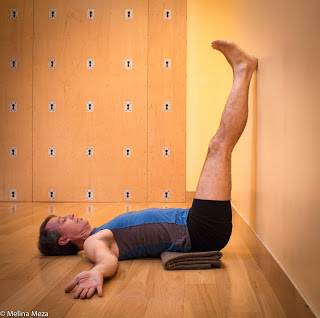by Nina
 |
| Rainbow in the Clouds by Melina Meza |
I just returned from a trip to Northern Europe and I had to laugh at myself because once again I ended up doing what I always do when I go on a trip: whenever I learn someone I know there or meet a new person who is complaining of being stressed out and having trouble sleeping, I simply cannot resist giving them a short yoga lesson! (Of course, I ask their permission first.) That’s because I have a couple of very simple tricks up my sleeve that I believe are very effective for reducing stress and improving sleep, and I think it’s worth taking the chance that my latest victim might benefit from them.
If you’ve been reading my posts for some time, you might have inkling of what those tricks are. But I won’t keep you in suspense. Here are my yoga tricks for stress and insomnia:
- Practicing a gentle supported inverted pose (see All About Supported Inverted Poses) in the evening before sleep or after any stressful encounter.
- Practicing breath awareness and/or exhalation lengthening in bed while falling asleep and also in the middle of the night when you can’t go back to sleep.
For this particular lesson, I first had my “victim” do a standing forward bend so I could assess her flexibility. That’s because I wanted to teach her Legs Up the Wall pose (Viparita Karani). But I know that this is not a comfortable pose for people who have very tight hamstrings, so my backup was Easy Inverted pose . In this victim’s case, she could easily touch the ground with her hands, so we were good to go with Legs Up the Wall pose.
Then, because this victim knew something about human physiology, I explained a bit about how supported inverted poses work (see Why You Should Love Your Baroreceptors). I wanted her to understand why using a prop under the pelvis in this pose was important (I demonstrated both the versions with and without the prop). Unfortunately, we had no access to yoga props or even blankets we could fold, so I grabbed the firmest bed pillow I could find to use under the pelvis. Even though it wasn’t as supportive as a yoga bolster or stack of folded blankets, it was better than nothing!
Next I had my victim go into the pose and made sure she was comfortable and well aligned.

I then explained breath awareness to her and suggested that part of the time in the pose she should focus on her breath.
Finally, I placed a folded silk scarf (hah—I always travel with those) on her eyes and asked her if she was game to try the pose for 20 minutes, and she agreed. That’s because I really feel that for the pose to take full effect you need to give it at least 10 minutes. Then I left the room, promising to return and bring her out of the pose when it was time. Of course, I also said she could come out at any time if it was getting to be too much for her.
And guess what—when I returned and instructed her to come out of the pose slowly, bringing her head up last, my victim most definitely had that “yoga look!” So I knew that being in the pose had triggered her relaxation response. And she herself told me how much different—and better—she felt.
After that because she was someone who knew a lot about exercise and human physiology and our time together was limited, I went ahead and taught her a bit about exhalation lengthening (which she was a bit familiar with from Pilates). I suggested she try either breath awareness or extending the exhalation when she woke in the night and couldn’t go back to sleep.
The next morning—we were staying together—when we met in the kitchen for tea, she was so pleased. My trick had worked, she said. She was able to use an exhalation lengthening breath practice in the middle of the night to take her mind off her worries and reduce her stress levels, and had fallen back to sleep.
Uh, oh! All that success has gone to my head. Who is going to be my next victim?
Follow Yoga for Healthy Aging on Facebook ° To order Yoga for Healthy Aging: A Guide to Lifelong Well-Being, go to Amazon, Shambhala, Indie Bound or your local bookstore.


Leave A Comment